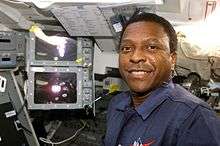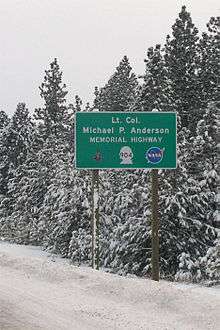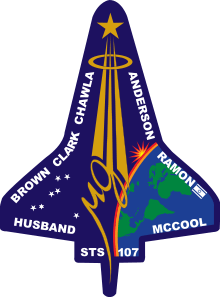Michael P. Anderson
| Michael P. Anderson | |
|---|---|
 1995 portrait | |
| NASA Astronaut | |
| Nationality | American |
| Status | Deceased |
| Born |
Michael Phillip Anderson December 25, 1959 Plattsburgh, New York, United States |
| Died |
February 1, 2003 (aged 43) over Texas |
Previous occupation | Pilot, Scientist |
|
Washington, B.S. 1981 Creighton, M.S. 1990 | |
| Rank | Lt. Colonel, USAF |
Time in space | 24d 18h 08m |
| Selection | 1994 NASA Group 15 |
| Missions | STS-89, STS-107 |
Mission insignia |
|
Michael Phillip Anderson (December 25, 1959 – February 1, 2003) was a United States Air Force officer and NASA astronaut, who was killed in the Space Shuttle Columbia disaster when the craft disintegrated after reentry into the Earth's atmosphere.
Anderson was born in Plattsburgh, New York, into an Air Force family and grew up as a military aspirant. He attended high school in Cheney, Washington, while his father was stationed at Fairchild Air Force Base, west of Spokane.
Education
- 1977: Graduated from Cheney High School in Cheney, Washington.
- 1981: Bachelor of Science degree in Physics/Astronomy from the University of Washington in Seattle.
- 1990: Master of Science degree in Рhysics from Creighton University in Omaha.
Special honors
- Distinguished graduate of USAF Communication Electronics Officers course
Experience
Anderson graduated from the University of Washington in 1981 and was commissioned a Second Lieutenant in the U.S. Air Force. After completing a year of technical training at Keesler Air Force Base, Mississippi, he was assigned to Randolph Air Force Base, Texas. At Randolph he served as Chief of Communication Maintenance for the 2015th Communication Squadron and later as Director of Information System Maintenance for the 1920th Information System Group.
In 1986 he was selected to attend Undergraduate Pilot Training at Vance Air Force Base, Oklahoma. Upon graduation he was assigned to the 2d Airborne Command and Control Squadron, Offutt Air Force Base, Nebraska as an EC-135 pilot, flying the Strategic Air Command's airborne command post code-named "Looking Glass." While stationed at Offutt, he completed his master's degree in physics at Creighton University in 1990.
From January 1991 to September 1992 he served as an aircraft commander and instructor pilot in the 920th Air Refueling Squadron, Wurtsmith Air Force Base, Michigan.
From September 1992 to February 1995 he was assigned as an instructor pilot and tactics officer in the 380th Air Refueling Wing, Plattsburgh Air Force Base, New York.
Anderson logged over 3,000 hours of flight in various models of the KC-135 and the T-38A aircraft.
NASA experience
Selected by NASA in December 1994, Anderson reported to the Johnson Space Center in March 1995. He completed a year of training and evaluation, and was qualified for flight crew assignment as a Mission Specialist. Anderson was initially assigned technical duties in the Flight Support Branch of the Astronaut Office. Anderson flew on missions STS-89 and STS-107, logging over 593 hours in space.
Space flight experience

STS-89 Space Shuttle Endeavour (January 22–31, 1998), was the eighth Shuttle-Mir docking mission during which the crew transferred more than 9,000 pounds of scientific equipment, logistical hardware and water from the Space Shuttle to Mir. In the fifth and last exchange of a U.S. astronaut, STS-89 delivered Andy Thomas to Mir and returned with David Wolf. Mission duration was 8 days, 19 hours and 47 seconds, traveling 3.6 million miles in 138 orbits of the Earth.
STS-107 Columbia (January 16 to February 1, 2003). The 16-day flight was a dedicated science and research mission. Working 24 hours a day, in two alternating shifts, the crew successfully conducted approximately 80 experiments. However as the space shuttle began to launch, suspicions arose that the shuttle's wing was seriously damaged by a foaming failure. Despite the suspicions NASA mistakenly said that the damages was only a small scrape to the wing; damage that would not have been threatening to the shuttle.
The STS-107 mission ended on February 1, 2003 when the Space Shuttle Columbia disintegrated as it was attempting to re-enter the atmosphere. Damage to the shuttle sustained during liftoff allowed hot re-entry gases to enter the left wing, dooming the orbiter. Anderson perished during the break-up and his body was discovered in a rural farm-field in Texas.
The mission duration was 15 days, 22 hours and 20 minutes. A NASA investigation found that the damage to the wing from the foaming failure was responsible for the fate of the shuttle and crew. NASA took full responsibility for the mistake and publicly apologized, making changes to their program.
Quotes
Prior to the final launch of the Columbia, Anderson stated: "There's always that unknown."
Personal
Anderson left behind a wife, Sandra Hawkins, and two daughters, ages 9 and 11. He was also survived by his parents and three sisters.
Awards
 | |||
Tributes

Lt. Col. Michael P. Anderson.
- State Route 904, running through Cheney, Washington, where he graduated from high school, was renamed in his memory.
- The science and math wing of Cheney High School is dedicated to his memory.
- Asteroid 51824 Mikeanderson was posthumously named after Anderson.
- Anderson Hall, in the Columbia Village apartments at the Florida Institute of Technology is named after him.
- Anderson Plaza, the green space in front of the Hixson-Lied Science Center at Creighton University was named after him in a compromise between the student body, who wanted the Science Center named for Anderson, and the administration who had already sold the naming rights to the Hixson-Lied family.
- Blair Elementary School on Fairchild Air Force Base in Washington was renamed Michael Anderson Elementary School in January 2004. Anderson attended the school as a fifth-grader.[1]
- Avondale Elementary School in Avondale, Arizona was renamed Michael Anderson Elementary in his honor. He attended school there when he was in 3rd grade, and one of the school T-shirts was aboard the Columbia on its last voyage.
- In 2003 he was inducted into the International Forest of Friendship, in Atchison, KS as part of a memorial to the Columbia astronauts.[2]
- Anderson Park in Canton, Mississippi was dedicated in June 2004.
- An outdoor bronze statue of Anderson was unveiled in Spokane in June 2005. Larger-than-life, it was created by local artist Dorothy Fowler, and shows Anderson kneeling with his helmet in one hand and a dove in the other.[3][4]
- A duplicate statue was dedicated at the Museum of Flight in Seattle in June 2009[5] and the museum launched an aerospace program in his honor.[6]
See also
References
- ↑ Kromer, Kristen (October 3, 2003). "New school honors Cheney astronaut". Spokesman-Review. p. B2.
- ↑ The International Forest of Friendship(http://www.ifof.org) is a living, growing memorial to the world history of aviation and aerospace in Amelia Earhart's hometown.
- ↑ Kraus, Hilary (June 11, 2005). "Michael P. Anderson statue to be dedicated in public ceremony". Spokesman-Review.
- ↑ "Photo". Michael Anderson Memorial Statue. Retrieved October 3, 2012.
- ↑ "Museum of Flight statue honors Washington state astronaut Michael P. Anderson". Museum of Flight. June 26, 2009. Retrieved October 3, 2012.
- ↑ "Michael P. Anderson Memorial Aerospace Program". Museum of Flight. Retrieved October 3, 2012.
External links
- NASA biography
- Michael Anderson STS-107 Crew Memorial
- Florida Today - Florida Tech dedicates dorms to Columbia 7 - October 29, 2003
- The Chicago Alliance for Minority Participation Keynote Address by Major Michael P. Anderson
- Spacefacts biography of Michael P. Anderson
- Museum of Flight: Michael P. Anderson Memorial Aerospace Program
- HistoryLink.org: Michael P. Anderson

